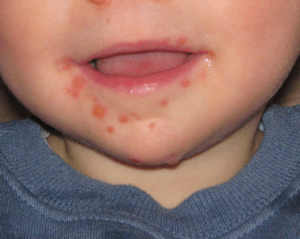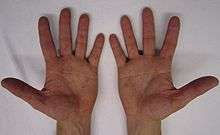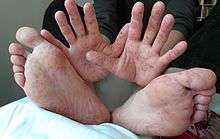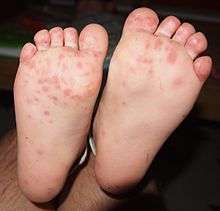Hand, foot, and mouth disease
| Hand, foot and mouth disease | |
|---|---|
 | |
| Typical lesions around the mouth of an 11-month-old boy | |
| Classification and external resources | |
| Specialty | Infectious disease |
| ICD-10 | B08.4 |
| ICD-9-CM | 074.3 |
| DiseasesDB | 5622 |
| MedlinePlus | 000965 |
| eMedicine | derm/175 |
| Patient UK | Hand, foot, and mouth disease |
| MeSH | D006232 |
Hand, foot and mouth disease (HFMD) is a common infection caused by a group of viruses.[1] It typically begins with a fever and feeling generally unwell.[1] This is followed a day or two later by flat discolored spots or bumps that may blister, on the hands, feet, and mouth, and occasionally buttocks and groin.[2][3][4] Signs and symptoms normally appear 3–6 days after exposure to the virus.[5] The rash generally goes away on its own in about a week.[6] Fingernail and toenail loss may occur a few weeks later and these then regrow.[7]
The viruses that cause HFMD are spread through close personal contact, through the air from coughing, and the feces of an infected person. Contaminated objects can also spread the disease.[8] Coxsackievirus A16 is the most common cause and Enterovirus 71 is the second-most common cause.[9] Other strains of coxsackievirus and enterovirus can also be responsible.[9][10] Some people may carry and pass on the virus despite having no symptoms of disease.[1] Other animals are not involved.[8] Diagnosis can often be made based on symptoms. Occasionally throat or stool sample may be tested for the virus.[11]
Handwashing may prevent spread and those infected should not go to work, daycare, or school.[8] No antiviral medication or vaccine is available, but development efforts are underway.[12] Most cases require no specific treatment.[6] Simple pain medication such as ibuprofen or numbing mouth gel may be used. Occasionally intravenous fluids are given to children who are unable to drink enough.[13] Rarely viral meningitis or encephalitis may complicate the disease.[7]
HFMD occurs in all areas of the world.[14] It often occurs in small outbreaks in nursery schools or kindergartens.[4] Large outbreaks have been occurring in Asia since 1997. It usually occurs during the spring, summer, and fall months.[14] Typically it occurs in children less than five years old, but can occasionally occur in adults.[1][4] HFMD should not be confused with foot-and-mouth disease (also known as hoof-and-mouth disease) which mostly affects livestock.[15]
Signs and symptoms



Common constitutional signs and symptoms of the HFMD include fever, nausea, vomiting, feeling tired, generalized discomfort, loss of appetite, and irritability in infants and toddlers. Skin lesions frequently develop in the form of a rash of flat discolored spots and bumps which may be followed by vesicular sores with blisters on palms of the hands, soles of the feet, buttocks, and sometimes on the lips.[16] The rash is rarely itchy for children,[5] but can be extremely itchy for adults. Painful facial ulcers, blisters, or lesions may also develop in or around the nose or mouth.[4][17][18] HFMD usually resolves on its own after 7–10 days.[17]
Cause
The viruses that cause the disease are of the Picornaviridae family. Coxsackievirus A16 is the most common cause of HFMD.[9] Enterovirus 71 (EV-71) is the second-most common cause.[9] Many other strains of coxsackievirus and enterovirus can also be responsible.[9][10]
Transmission
HFMD is highly contagious and is transmitted by nasopharyngeal secretions such as saliva or nasal mucus, by direct contact, or by fecal-oral transmission.
Diagnosis
A diagnosis usually can be made by the presenting signs and symptoms alone.[17] If the diagnosis is unclear, a throat swab or stool specimen may be taken to identify the virus by culture.[17] The common incubation period (the time between infection and onset of symptoms) ranges from three to six days.[5]
Prevention
Preventive measures include avoiding direct contact with infected individuals (including keeping infected children home from school), proper cleaning of shared utensils, disinfecting contaminated surfaces, and proper hand hygiene. These measures have been shown to be effective in decreasing the transmission of the viruses responsible for HFMD.[17][19]
Vaccine
A vaccine known as the EV71 vaccine is available to prevent HFMD in China as of December 2015.[20] No vaccine is currently available in the United States.[19]
Treatment
Medications are usually not needed as hand, foot and mouth disease is a viral disease that typically gets better on its own. Currently, there is no specific curative treatment for hand, foot and mouth disease.[17] Disease management typically focuses on achieving symptomatic relief. Pain from the sores may be eased with the use of analgesic medications. Infection in older children, adolescents, and adults is typically mild and lasts approximately 1 week, but may occasionally run a longer course. Fever reducers and lukewarm baths can help decrease body temperature.
A minority of individuals with hand, foot and mouth disease may require hospital admission due to complications such as inflammation of the brain, inflammation of the meninges, or acute flaccid paralysis.[10] Non-neurologic complications such as inflammation of the heart, fluid in the lungs, or bleeding into the lungs may also occur.[10]
Complications
Complications from the viral infections that cause HFMD are rare, but require immediate medical treatment if present. HFMD infections caused by Enterovirus 71 tend to be more severe and are more likely to have neurologic or cardiac complications including death than infections caused by Coxsackievirus A16.[17] Viral or aseptic meningitis can occur with HFMD in rare cases and is characterized by fever, headache, stiff neck, or back pain.[10][17] The condition is usually mild and clears without treatment; however, hospitalization for a short time may be needed. Other serious complications of HFMD include encephalitis (swelling of the brain), or flaccid paralysis in rare circumstances.[16][17]
Fingernail and toenail loss have been reported in children 4–8 weeks after having HFMD.[5] The relationship between HFMD and the reported nail loss is unclear; however, it is temporary and nail growth resumes without treatment.[5][21]
Epidemiology
Hand, foot and mouth disease most commonly occurs in children under the age of 10[5][17] and tends to occur in outbreaks during the spring, summer, and fall seasons.[9] HFMD is most commonly caused by infection with Coxsackievirus A16.[9]
Major outbreaks
- In 1998, there was an outbreak in Taiwan, affecting mainly children.[22] There were 405 severe complications, and 78 children died.[23] The total number of cases in that epidemic is estimated to have been 1.5 million.[9]
- In 2008 an outbreak in China, beginning in March in Fuyang, Anhui, led to 25,000 infections, and 42 deaths, by May 13.[9] Similar outbreaks were reported in Singapore (more than 2,600 cases as of April 20, 2008),[24] Vietnam (2,300 cases, 11 deaths),[25] Mongolia (1,600 cases),[26] and Brunei (1053 cases from June–August 2008)[27]
- In 2009 17 children died in an outbreak during March and April 2009 in China's eastern Shandong Province, and 18 children died in the neighboring Henan Province.[28] Out of 115,000 reported cases in China from January to April, 773 were severe and 50 were fatal.[29]
- In 2010 in China, an outbreak occurred in southern China's Guangxi Autonomous Region as well as Guangdong, Henan, Hebei and Shandong provinces. Until March 70,756 children were infected and 40 died from the disease. By June, the peak season for the disease, 537 had died.[30]
- The World Health Organization reporting between January to October 2011 (1,340,259) states the number of cases in China had dropped by approx 300,000 from 2010 (1,654,866) cases, with new cases peaking in June. There were 437 deaths, down from 2010 (537 deaths).[31]
- In December 2011, the California Department of Public Health identified a strong form of the virus, coxsackievirus A6 (CVA6), where nail loss in children is common.[32]
- In 2012 in Alabama, United States there was an outbreak of an unusual type of the disease. It occurred in a season when it is not usually seen and affected teenagers and older adults. There were some hospitalizations due to the disease but no reported deaths.[33]
- In 2012 in Cambodia, 52 of 59 reviewed cases of children reportedly[34] dead (as of July 9, 2012) due to a mysterious disease were diagnosed to be caused by a virulent form of HFMD.[35] Although a significant degree of uncertainty exists with reference to the diagnosis, the WHO report states, "Based on the latest laboratory results, a significant proportion of the samples tested positive for enterovirus 71 (EV-71), which causes hand foot and mouth disease (HFMD). The EV-71 virus has been known to generally cause severe complications amongst some patients."[36]
- HFMD infected 1,520,274 people with up to 431 deaths reported at the end of July in 2012 in China.[37]
- The governorate of Daraa in Syria reported over 200 cases of HFMD there in early 2015.[38] These were due to the central Syrian government denying the region water chlorination.
History
HFMD cases were first described in New Zealand in 1957.[17]
Research
Novel antiviral agents to prevent and treat infection with the viruses responsible for HFMD are currently under development. Preliminary studies have shown inhibitors of the EV-71 viral capsid to have potent antiviral activity.[12]
References
- 1 2 3 4 "Hand Foot and Mouth Disease". CDC. August 18, 2015. Retrieved 14 May 2016.
- ↑ Frydenberg, A; Starr, M (August 2003). "Hand, foot and mouth disease.". Australian family physician. 32 (8): 594–5. PMID 12973865.
- ↑ Ooi, MH; Wong, SC; Lewthwaite, P; Cardosa, MJ; Solomon, T (2010). "Clinical features, diagnosis, and management of enterovirus 71". Lancet Neurology. 9 (11): 1097–1105. doi:10.1016/S1474-4422(10)70209-X. PMID 20965438.
- 1 2 3 4 Kaminska, K; Martinetti, G; Lucchini, R; Kaya, G; Mainetti, C (2013). "Coxsackievirus A6 and Hand, Foot, and Mouth Disease: Three Case Reports of Familial Child-to-Immunocompetent Adult Transmission and a Literature Review". Case Reports in Dermatology. 5 (2): 203–209. doi:10.1159/000354533. PMID 24019771.
- 1 2 3 4 5 6 Hoy, NY; Leung, AK; Metelitsa, AI; Adams, S (2012). "New concepts in median nail dystrophy, onychomycosis, and hand, foot and mouth disease nail pathology". ISRN Dermatology. 2012 (680163): 680163. doi:10.5402/2012/680163. PMID 22462009.
- 1 2 Longo, Dan L. (2012). Harrison's principles of internal medicine. (18th ed.). New York: McGraw-Hill. ISBN 978-0-07174889-6.
- 1 2 "Hand, Foot, and Mouth Disease (HFMD) Complications". CDC. August 18, 2015. Retrieved 14 May 2016.
- 1 2 3 "Causes & Transmission". CDC. August 18, 2015. Retrieved 15 May 2016.
- 1 2 3 4 5 6 7 8 9 Repass GL, Palmer WC, Stancampiano FF (September 2014). "Hand, foot, and mouth disease: Identifying and managing an acute viral syndrome". Cleve Clin J Med. 81 (9): 537–43. doi:10.3949/ccjm.81a.13132. PMID 25183845.
- 1 2 3 4 5 Li, Y; Zhu, R; Qian, Y; Deng, J (2012). "The characteristics of blood glucose and WBC counts in peripheral blood of cases of hand foot and mouth disease in China: a systematic review". PLOS ONE. 7 (1): e29003. doi:10.1371/journal.pone.0029003. PMC 3250408
 . PMID 22235257.
. PMID 22235257. - ↑ "Diagnosis". CDC. August 18, 2015. Retrieved 15 May 2016.
- 1 2 Pourianfar HR, Grollo L (February 2014). "Development of antiviral agents toward enterovirus 71 infection". J Microbiol Immunol Infect. 48: 1–8. doi:10.1016/j.jmii.2013.11.011. PMID 24560700.
- ↑ "Prevention & Treatment". CDC. August 18, 2015. Retrieved 15 May 2016.
- 1 2 "Outbreaks". CDC. August 18, 2015. Retrieved 15 May 2016.
- ↑ "Foot and Mouth Disease update: further temporary control zone established in Surrey". Defra. 2007-08-14. Archived from the original on 2007-09-27. Retrieved 2007-08-14.
- 1 2 Huang, CC; Liu, CC; Chang, YC; Chen, CY; Wang, ST; Yeh, TF (23 September 1999). "Neurologic complications in children with enterovirus 71 infection.". The New England Journal of Medicine. 341 (13): 936–42. doi:10.1056/nejm199909233411302. PMID 10498488.
- 1 2 3 4 5 6 7 8 9 10 11 Sarma, N (March–April 2013). "Hand, foot and mouth disease: current scenario and Indian perspective". Indian Journal of Dermatology, Venereology, and Leprology. 79 (2): 165–175. doi:10.4103/0378-6323.107631. PMID 23442455.
- ↑ "Hand, Foot and Mouth Disease: Signs & Symptoms". mayoclinic.com. The Mayo Clinic. Retrieved May 5, 2008.
- 1 2 "Hand, Foot and Mouth Disease". Prevention and Treatment. Centers for Disease Control and Prevention. 2013. Retrieved 18 October 2013.
- ↑ Mao, QY; Wang, Y; Bian, L; Xu, M; Liang, Z (May 2016). "EV71 vaccine, a new tool to control outbreaks of hand, foot and mouth disease (HFMD).". Expert review of vaccines. 15 (5): 599–606. doi:10.1586/14760584.2016.1138862. PMID 26732723.
- ↑ "Hand, Foot and Mouth Disease". Complications. Centers for Disease Control and Prevention. 2011. Retrieved 14 October 2013.
- ↑ Centers for Disease Control and Prevention (CDC) (1998). "Deaths among children during an outbreak of hand, foot, and mouth disease--Taiwan, Republic of China, April–July 1998". MMWR Morb. Mortal. Wkly. Rep. 47 (30): 629–32. PMID 9704628.
- ↑ Ho M, Chen ER, Hsu KH, et al. (1999). "An epidemic of enterovirus 71 infection in Taiwan. Taiwan Enterovirus Epidemic Working Group". N. Engl. J. Med. 341 (13): 929–35. doi:10.1056/NEJM199909233411301. PMID 10498487.
- ↑ Suhaimi, Nur Dianah (April 20, 2008). "HFMD: 1,000 cases a week is unusual, says doc". Singapore: The Sunday Times (Straits Times). pp. 1–2.
- ↑ Viet Nam News: HFMD cases prompt tighter health screening at airport(accessed May 15, 2008)
- ↑ EV-71 Virus Continues Dramatic Rise (accessed May 23, 2008)
- ↑ Bandar Seri Begawan (7 November 2008). "1,053 HFD cases recorded". The Birmingham News. Retrieved May 11, 2012.
- ↑ "Hand-foot-mouth disease death toll rises to 17 in East China's Shandong Province". China View. April 9, 2009. Retrieved September 29, 2009.
- ↑ "Health Ministry: Hand-foot-mouth disease claims 50 lives this year". China View. 10 April 2009. Retrieved 29 September 2009.
- ↑ http://news.xinhuanet.com/english2010/china/2010-06/24/c_13367598.htm
- ↑ "China reports 537 deaths from hand-foot-mouth disease this year". People's Daily Online. 2010. Retrieved 16 October 2013.
- ↑ "Coxsackievirus A6 (CVA6)". California Department of Public Health. 2013. Retrieved 16 October 2013.
- ↑ Hannah Wolfson (February 13, 2012). "Outbreak of hand, foot and mouth disease severe in Alabama". The Birmingham News. Retrieved May 11, 2012.
- ↑ CBS News Staff (2012). "Joint Press Release Between The Ministry of Health Kingdom of Cambodia and the World Health Organization" (PDF). CBS News. Retrieved 16 October 2013.
- ↑ "Mysterious deadly illness in Cambodian children tied to hand, foot and mouth disease". Hand, Foot and Mouth Disease. World Health Organization. 2012. Retrieved 16 October 2013.
- ↑ "Global Alert and Response (GAR)". Undiagnosed illness in Cambodia-update. World Health Organization. 2012. Retrieved 16 October 2013.
- ↑ "Emerging disease surveillance and response". Hand, Foot and Mouth Disease. World Health Organization. 2013. Retrieved 16 October 2013.
- ↑ Sparrow, Annie (2015), "Syria: Death from Assad’s Chlorine", The New York Review of Books, (7 May issue).
External links
![]() Media related to Hand, foot and mouth disease at Wikimedia Commons
Media related to Hand, foot and mouth disease at Wikimedia Commons
![]() News related to Highly contagious Hand, foot and mouth disease killing China's children at Wikinews
News related to Highly contagious Hand, foot and mouth disease killing China's children at Wikinews